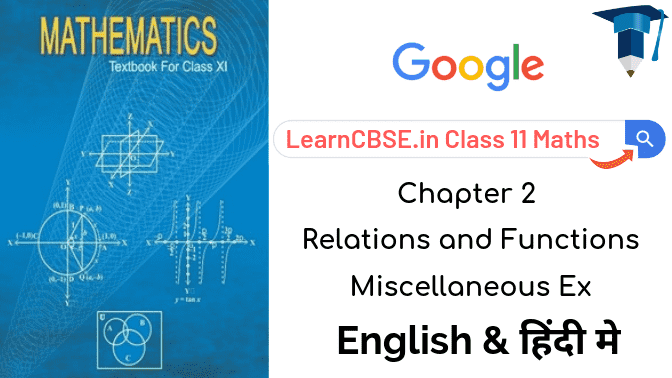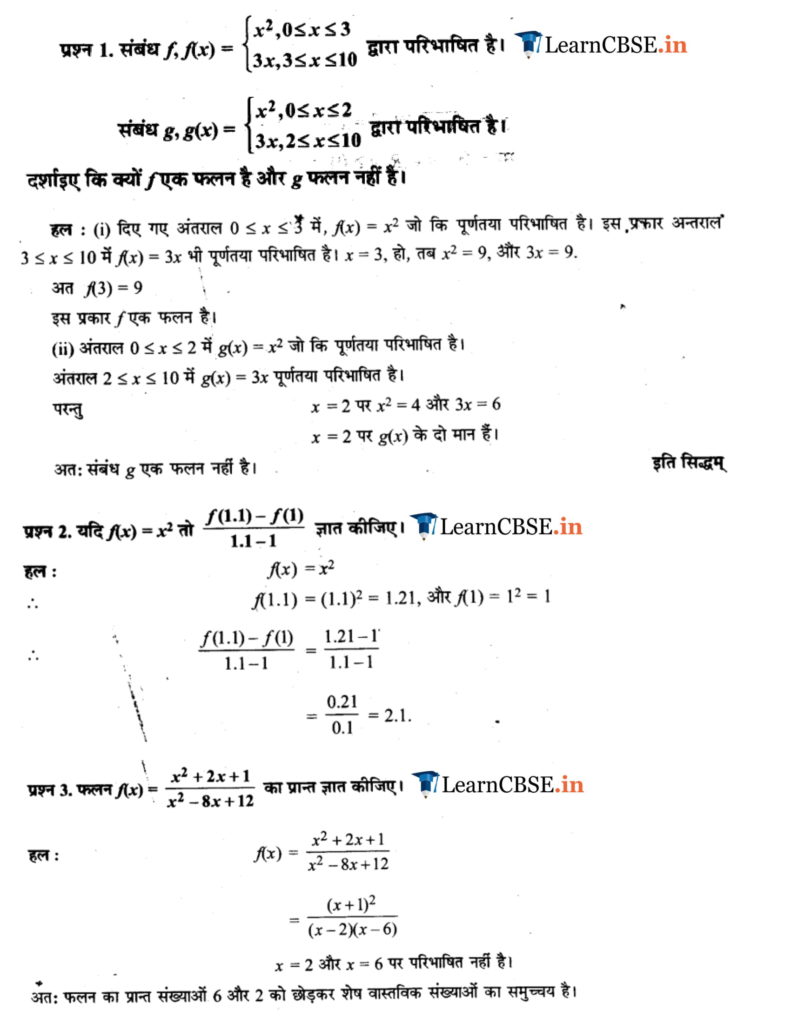Get Free NCERT Solutions for Class 11 Maths Chapter 2 Relations and Functions Miscellaneous Exercise PDF in Hindi and English Medium. Relations and Functions Class 11 Maths NCERT Solutions are extremely helpful while doing your homework. Relations and Functions Miscellaneous Exercise Class 11 Maths NCERT Solutions were prepared by Experienced LearnCBSE.in Teachers. Detailed answers of all the questions in Chapter 2 Class 11 Relations and Functions Miscellaneous Exercise provided in NCERT Textbook.
- Relations and Functions Class 11 Ex 2.1
- Relations and Functions Class 11 Ex 2.2
- Relations and Functions Class 11 Ex 2.3
- Relations and Functions Class 11 Miscellaneous Exercise
- संबंध एवं फलन प्रश्नावली 2.1 का हल हिंदी में
- संबंध एवं फलन प्रश्नावली 2.2 का हल हिंदी में
- संबंध एवं फलन प्रश्नावली 2.3 का हल हिंदी में
- संबंध एवं फलन विविध प्रश्नावली का हल हिंदी में
- NCERT Exemplar Class 11 Maths Chapter 2 Relations and Functions
- Relations and Functions Class 11 Notes
- Relations and Functions Formulas
- RD Sharma Class 11 Solutions Chapter 2 Relations
Free download NCERT Solutions for Class 11 Maths Chapter 2 Relations and Functions Miscellaneous Exercise PDF in Hindi Medium as well as in English Medium for CBSE, Uttarakhand, Bihar, MP Board, Gujarat Board, BIE, Intermediate and UP Board students, who are using NCERT Books based on updated CBSE Syllabus for the session 2019-20.
NCERT Solutions for Class 11 Maths Chapter 2 Miscellaneous Exercise

Question-1

Ans.

Question-2

Ans.

Question-3

Ans.

Question-4
![]()
Ans.

Question-5
![]()
Ans.

Question-6

Ans.

Question-7

Ans.

Question-8

Ans.

Question-9

Ans.

Question-10

Ans.

Question-11
![]()
Ans.

Question-12

Ans.

NCERT Solutions for Class 11 Maths Chapter 2 Relations and Functions Miscellaneous Exercise
अध्याय 2 पर विविध प्रश्नावली





प्रश्न 8.
मान लीजिए कि f = {(1, 1), (2, 3), (0, -1), (-1, -3)} Z से Z में, f(x) = ax + b, द्वारा परिभाषित एक फलन है, जहाँ a, b कोई पूर्णाक हैं। a, b को निर्धारित कीजिए।
हल:
दिया है :
f = {(1, 1), (2, 3), (0, – 1), (-1, – 3)}
और f(x) = ax + b …..(A)
जब x = 1; y = 1, हो तब a + b = 1 …..(i)
और जबे x = 2, y = 3, 2a + b = 3 …..(ii)
समीकरण (i) और (ii) से,
a = 2, b = -1
a तथा b के इन मानों को समीकरण (A) में रखने पर,
f(x) = 2x – 1
जब x = 0, f(x) = -1
और जब x = -1, f(x) = -3
अतः f(x) = 2x – 1 तथा a = 2, b = -1.
प्रश्न 9.
R = {(a, b) : a, b ∈ N तथा a = b2} द्वारा परिभाषित N से N में, एक संबंध R है। क्या निम्नलिखित कथन सत्य है।
(i) {a, a} ∈ R सभी a ∈ N
(ii) (a, b) ∈ R का तात्पर्य है कि (b, a) ∈ R
(iii) (a, b) ∈ R, (b, c) ∈ R का तात्पर्य है कि (a, c) ∈ R? प्रत्येक दशा में अपने उत्तर का औचित्य भी बताइए।
हल:
(i) a = a यह सत्य है जब a = 0, 0 ∉ N,
अत: यह एक संबंध नहीं है।
(ii) a = b2, और b = a2, यह a, b ∈ N, a, b के सभी मूल्यों के लिए सत्य नहीं है। अत: यह एक संबंध नहीं है।
(iii) जब a = b2, b = c2 तब a ≠ c2
यह संबंध नहीं है।
प्रश्न 10.
मान लीजिए A = {1, 2, 3, 4}, B = {1, 5, 9, 11, 15, 16} और f = {(1, 5), (2, 9), (3, 1), (4, 5), (2, 11)}, क्या निम्नलिखित कथन सत्य है ?
(i) f, Aसे B में एक संबंध है।
(ii) f, A से B में एक फलन है। प्रत्येक दशा में अपने उत्तर का औचित्य बताइए।
हल:
(i) दिया है: A = {1, 2, 3, 4} तथा B = {1, 5, 9, 11, 15, 16}
A x B = {(1, 1), (1, 5), (1, 9), (1,11), (1, 15), (1, 16), (2, 1), (2, 5), (2, 9), (2, 11), (2, 15), (2, 16), (3, 1), (3, 5), (3, 9), (3, 11), (3, 15), (3,16), (4, 1), (4, 5), (4,9), (4, 11), (4, 15), (4, 16)}
अवयव, A x B का उपसमुच्चय है।
अतः यह एक संबंध है।
(ii) f में (2, 9) और (2, 11) अवयव प्रथम घटक दोनों युग्मों में 2 है।
यह फलन नहीं है।
प्रश्न 11.
मान लीजिए कि f, f = {(ab, a + b); a, b ∈ Z} द्वारा परिभाषित Z x Z का एक उपसमुच्चय है। क्या f, Z से Z में एक फलन है ? अपने उत्तर का औचित्य भी स्पष्ट कीजिए।
हल:
मान लीजिए a = 0, b = 1 हो, तब
ab = 0 और a + b = 0 + 1 = 1
पुनः माना a = 0, b = 2 हो, तब
ab = 0, a + b = 2.
अवयव 0 के दो प्रतिबिंब 1 और 2 हैं।
अत: f एक फलन नहीं है।
प्रश्न 12.
मान लीजिए कि A= {9, 10, 11, 12, 13} तथा f : A → N, f(n) = n का महत्तम अभाज्य गुणक द्वारा परिभाषित है।/का परिसर ज्ञात करो।
हल:
यदि n = 9 = 3 x 3 तो 3 इन गुणनखंडों में सबसे बड़ी अभाज्य संख्या है।
n= 10 = 2 x 5 तो 5 इन गुणनखंडों में सबसे बड़ी अभाज्य संख्या है।
n = 11 = 1 x 11 तो 11 इन गुणनखंडों में सबसे बड़ी अभाज्य संख्या है।
n = 12 = 22 x 3 तो 3 इन गुणनखंडों में सबसे बड़ी अभाज्य संख्या है।
n = 13 = 1 x 13 तो 13 इन गुणनखंडों में सबसे बड़ी अभाज्य संख्या है।
अतः f का परिसर = {3, 5, 11, 13}.